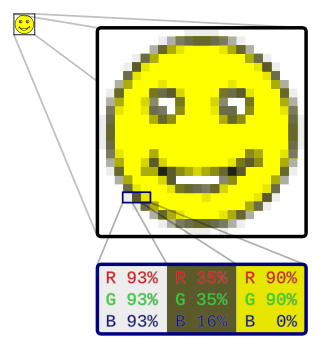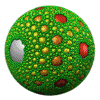Related Research Articles
Portable Document Format (PDF), standardized as ISO 32000, is a file format developed by Adobe in 1992 to present documents, including text formatting and images, in a manner independent of application software, hardware, and operating systems. Based on the PostScript language, each PDF file encapsulates a complete description of a fixed-layout flat document, including the text, fonts, vector graphics, raster images and other information needed to display it. PDF has its roots in "The Camelot Project" initiated by Adobe co-founder John Warnock in 1991. PDF was standardized as ISO 32000 in 2008. The last edition as ISO 32000-2:2020 was published in December 2020.

PostScript is a page description language and dynamically typed, stack-based programming language. It is most commonly used in the electronic publishing and desktop publishing realm, but as a Turing complete programming language, it can be used for many other purposes as well. PostScript was created at Adobe Systems by John Warnock, Charles Geschke, Doug Brotz, Ed Taft and Bill Paxton from 1982 to 1984. The most recent version, PostScript 3, was released in 1997.
Adobe Photoshop is a raster graphics editor developed and published by Adobe Inc. for Windows and macOS. It was originally created in 1987 by Thomas and John Knoll. Since then, the software has become the most used tool for professional digital art, especially in raster graphics editing. The software's name is often colloquially used as a verb although Adobe discourages such use.

In computer graphics and digital photography, a raster graphic represents a two-dimensional picture as a rectangular matrix or grid of square pixels, viewable via a computer display, paper, or other display medium. A raster is technically characterized by the width and height of the image in pixels and by the number of bits per pixel. Raster images are stored in image files with varying dissemination, production, generation, and acquisition formats.

The CMYK color model is a subtractive color model, based on the CMY color model, used in color printing, and is also used to describe the printing process itself. The abbreviation CMYK refers to the four ink plates used: cyan, magenta, yellow, and key (black).

The LaserWriter is a laser printer with built-in PostScript interpreter sold by Apple, Inc. from 1985 to 1988. It was one of the first laser printers available to the mass market. In combination with WYSIWYG publishing software like PageMaker, that operated on top of the graphical user interface of Macintosh computers, the LaserWriter was a key component at the beginning of the desktop publishing revolution.

Aldus Corporation was an American software company best known for its pioneering desktop publishing software. PageMaker, the company's most well-known product, ushered in the modern era of desktop computers such as the Macintosh seeing widespread use in the publishing industry. Paul Brainerd, the company's co-founder, coined the term desktop publishing to describe this paradigm. The company also originated the Tag Image File Format (TIFF) file format, widely used in the digital graphics profession.
PostScript Printer Description (PPD) files are created by vendors to describe the entire set of features and capabilities available for their PostScript printers.

Transparency in computer graphics is possible in a number of file formats. The term "transparency" is used in various ways by different people, but at its simplest there is "full transparency" i.e. something that is completely invisible. Only part of a graphic should be fully transparent, or there would be nothing to see. More complex is "partial transparency" or "translucency" where the effect is achieved that a graphic is partially transparent in the same way as colored glass. Since ultimately a printed page or computer or television screen can only be one color at a point, partial transparency is always simulated at some level by mixing colors. There are many different ways to mix colors, so in some cases transparency is ambiguous.
Prepress is the term used in the printing and publishing industries for the processes and procedures that occur between the creation of a print layout and the final printing. The prepress process includes the preparation of artwork for press, media selection, proofing, quality control checks and the production of printing plates if required. The artwork is often provided by the customer as a print-ready PDF file created in desktop publishing.
Hexachrome is a discontinued six-color printing process designed by Pantone. In addition to custom CMYK inks, Hexachrome uses orange and green inks to expand the color gamut for better color reproduction. It is therefore also known as a CMYKOG process.
A computer font is implemented as a digital data file containing a set of graphically related glyphs. A computer font is designed and created using a font editor. A computer font specifically designed for the computer screen, and not for printing, is a screen font.
A number of vector graphics editors exist for various platforms. Potential users of these editors will make a comparison of vector graphics editors based on factors such as the availability for the user's platform, the software license, the feature set, the merits of the user interface (UI) and the focus of the program. Some programs are more suitable for artistic work while others are better for technical drawings. Another important factor is the application's support of various vector and bitmap image formats for import and export.
Open XML Paper Specification is an open specification for a page description language and a fixed-document format. Microsoft developed it as the XML Paper Specification (XPS). In June 2009, Ecma International adopted it as international standard ECMA-388.
In printing, Preflight is the process of confirming that the digital files required for the printing process are all present, valid, correctly formatted, and of the desired type. The basic idea is to prepare the files to make them feasible for the correct process such as offset printing and eliminate costly errors and facilitate a smooth production. It is a standard prepress procedure in the printing industry. The term originates from the preflight checklists used by pilots. The term was first used in a presentation at the Color Connections conference in 1990 by consultant Chuck Weger, and Professor Ron Bertolina was a pioneer for solutions to preflighting in the 1990s.

Barco Creator was an image manipulation program targeted at the repro and print shop markets. It was developed by Barco Creative Systems a division of the Barco Group and first shown as a prototype at Parigraph in April 1988, then later at Ipex 88). Barco Creative Systems together with D.I.S.C. and Aesthedes merged into Barco Graphics. It ran on several generations of Silicon Graphics computers till the late 1990s. Barco Graphics ColorTone for Windows NT is considered its successor.
In color management, an ICC profile is a set of data that characterizes a color input or output device, or a color space, according to standards promulgated by the International Color Consortium (ICC). Profiles describe the color attributes of a particular device or viewing requirement by defining a mapping between the device source or target color space and a profile connection space (PCS). This PCS is either CIELAB (L*a*b*) or CIEXYZ. Mappings may be specified using tables, to which interpolation is applied, or through a series of parameters for transformations.
Camera-ready is a common term used in the commercial printing industry meaning that a document is, from a technical standpoint, ready to "go to press", or be printed.
Scitex Continuous Tone or Scitex CT is an image file format. It is designed specifically for use on Scitex graphics processing equipment. Its use is supported by numerous graphics suites and desktop publishing packages, such as Adobe Photoshop, Adobe InDesign, and QuarkXPress.
References
- 1 2 3 "OPI and DCS Desktop Color Separation Method Comparison". Adobe Systems Inc. Archived from the original on 2016-08-22.
- 1 2 Bear, Jacci Howard. "DCS". About.Com. Archived from the original on 2009-08-26. Retrieved 2009-11-03.
- ↑ Powers, Lynn (1993-12-10). "Desktop Color Separation (DCS) General Information". Adobe Inc. Archived from the original on 2016-08-22.